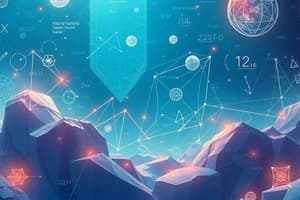Podcast
Questions and Answers
What is a function in mathematics?
What is a function in mathematics?
- A structure for representing data.
- A statement of equality between expressions.
- A relationship between inputs and outputs. (correct)
- An ordered list of numbers.
Which of the following best describes an inequality?
Which of the following best describes an inequality?
- A visual depiction of data structures.
- A calculation of the sum of a series.
- A representation of a linear equation.
- A statement showing a relationship between numbers. (correct)
What is the first step in problem-solving strategies?
What is the first step in problem-solving strategies?
- Implementing the plan.
- Devising a plan.
- Evaluating the solution.
- Identifying the unknown. (correct)
How is math applied in the field of finance?
How is math applied in the field of finance?
What are matrices used for in mathematics?
What are matrices used for in mathematics?
Which branch of mathematics deals with shapes and their properties?
Which branch of mathematics deals with shapes and their properties?
What does algebra primarily use to represent unknowns?
What does algebra primarily use to represent unknowns?
What is the main focus of calculus?
What is the main focus of calculus?
Which of the following is NOT a property fundamental to arithmetic?
Which of the following is NOT a property fundamental to arithmetic?
Which type of number is not considered a rational number?
Which type of number is not considered a rational number?
In statistics, what describes the measure of central tendency?
In statistics, what describes the measure of central tendency?
What mathematical operation is NOT part of arithmetic?
What mathematical operation is NOT part of arithmetic?
Sets in mathematics are defined as:
Sets in mathematics are defined as:
Flashcards
Function
Function
A relationship between inputs and outputs where each input has exactly one output.
Equation
Equation
Mathematical statements expressing an equality between expressions.
Inequality
Inequality
Mathematical statements comparing two expressions using symbols like '>' (greater than) or '<' (less than).
Matrices
Matrices
Signup and view all the flashcards
Identifying the unknown
Identifying the unknown
Signup and view all the flashcards
Arithmetic
Arithmetic
Signup and view all the flashcards
Algebra
Algebra
Signup and view all the flashcards
Geometry
Geometry
Signup and view all the flashcards
Calculus
Calculus
Signup and view all the flashcards
Statistics
Statistics
Signup and view all the flashcards
Integers
Integers
Signup and view all the flashcards
Rational Numbers
Rational Numbers
Signup and view all the flashcards
Irrational Numbers
Irrational Numbers
Signup and view all the flashcards
Study Notes
Fundamental Concepts
- Mathematics is a formal system of logic and reasoning used to quantify, model, and understand the world around us.
- It involves the study of abstract concepts like numbers, shapes, and patterns, and their interactions and relationships.
- Key branches of mathematics include arithmetic, algebra, geometry, calculus, and statistics.
Arithmetic
- Arithmetic deals with basic operations on numbers: addition, subtraction, multiplication, and division.
- It forms a foundation for more advanced mathematical concepts.
- Properties like commutativity, associativity, and distributivity are fundamental in arithmetic.
Algebra
- Algebra uses variables and symbols to represent unknowns and relationships between quantities.
- It allows for the manipulation of equations and expressions to solve problems.
- Core algebraic techniques include solving equations, simplifying expressions, and factoring.
Geometry
- Geometry deals with shapes, their properties, and spatial relationships.
- It involves concepts like points, lines, angles, triangles, circles, and three-dimensional figures.
- Geometric theorems and postulates provide a framework for understanding spatial reasoning.
Calculus
- Calculus deals with motion and change.
- It involves concepts like derivatives and integrals to calculate rates of change and accumulation.
- Applications include analyzing curves, solving optimization problems, and calculating areas and volumes.
- Key components are differential calculus (rates of change) and integral calculus (accumulation).
Statistics
- Statistics deals with collecting, analyzing, and interpreting data.
- It involves measures of central tendency (mean, median, mode) and dispersion (variance, standard deviation).
- Applications include probability, prediction, and hypothesis testing.
Types of Numbers
- Numbers are categorized into natural numbers (1, 2, 3,...), whole numbers (0, 1, 2, 3,...), integers (-3, -2, -1, 0, 1, 2, 3,...), rational numbers (fractions), irrational numbers (non-repeating decimals like pi), real numbers (rational and irrational), and complex numbers (with imaginary components).
- Each set of numbers has unique properties and relationships to other sets.
Sets and Logic
- Sets are collections of objects.
- Set theory formally defines collections of numbers and studies their properties.
- Mathematical logic and proofs are fundamental in verifying and establishing mathematical truths.
Important Concepts in Math
- Functions: Relationships between inputs and outputs.
- Equations: Statements of equality between expressions.
- Inequalities: Statements of comparison between expressions.
- Matrices and Vectors: Specialized structures for representing and manipulating data.
- Graphs and Networks: Visual representations of relationships and connections.
- Sequences and Series: Ordered lists of numbers and their sums.
Problem Solving Strategies
- Identifying the unknown: Defining what needs to be found.
- Devising a plan: Creating a strategy for solving the problem.
- Implementing the plan: Executing steps of the chosen strategy.
- Evaluating the solution: Checking the result for correctness.
Applications of Math
- Math is crucial in many fields: science, engineering, finance, computer science, and business.
- It provides tools for modeling, analyzing, and predicting phenomena.
- It helps understand and quantify the world around us.
Studying That Suits You
Use AI to generate personalized quizzes and flashcards to suit your learning preferences.




